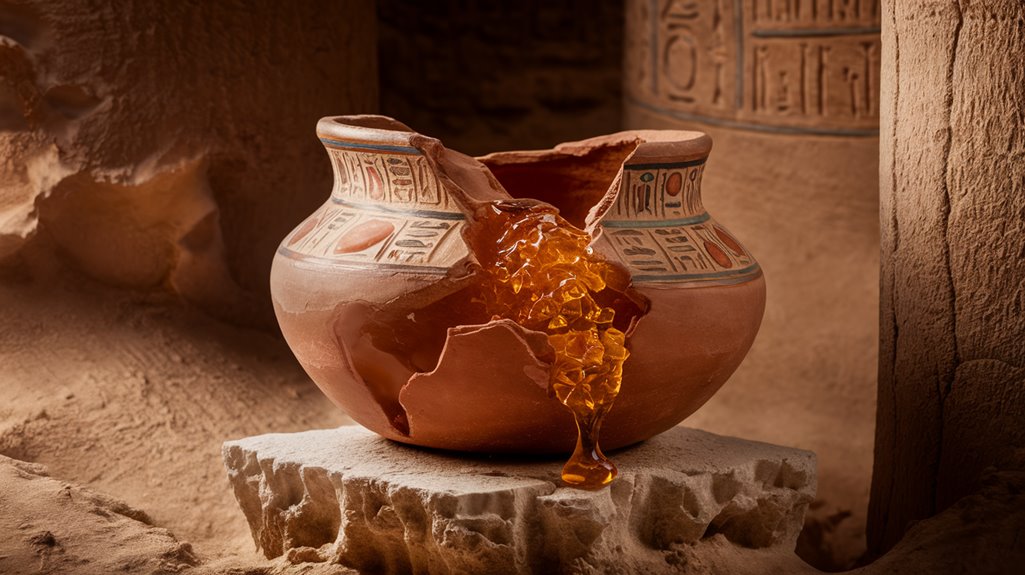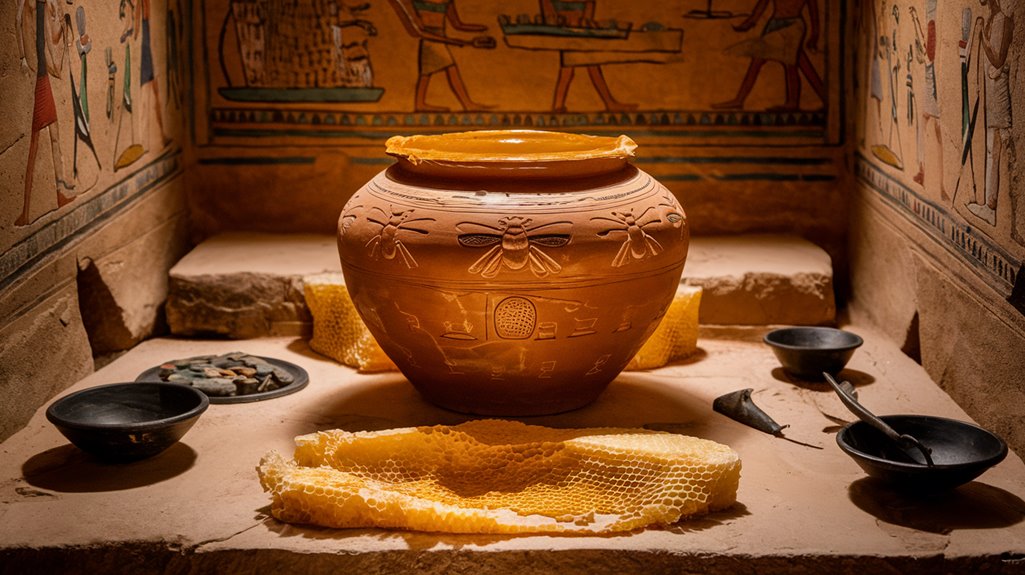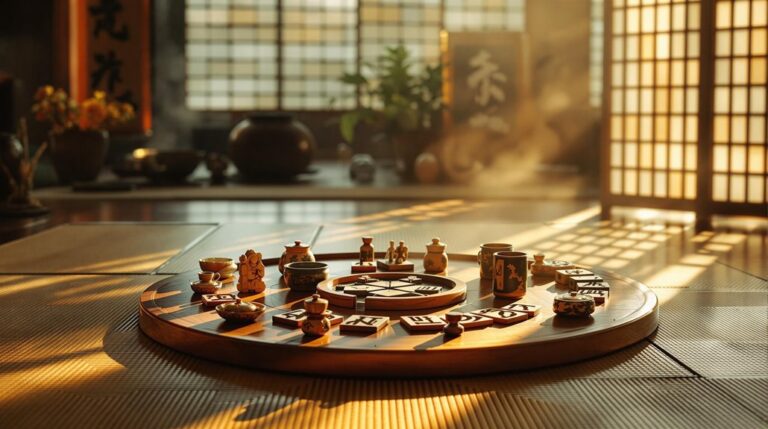3,000-Year-Old Edible Honey Has Been Found by Archaeologists
You might think honey's just another item in your pantry, but this golden substance has proven itself virtually immortal. When archaeologists discovered 3,000-year-old honey pots in Egyptian tombs, including King Tutankhamun's burial chamber, they found the contents were still perfectly edible. This remarkable preservation isn't just a lucky accident – it's the result of honey's unique chemical properties. The ancient Egyptians understood something about food preservation that we're only now beginning to fully appreciate.
The Remarkable Discovery in Egyptian Tombs
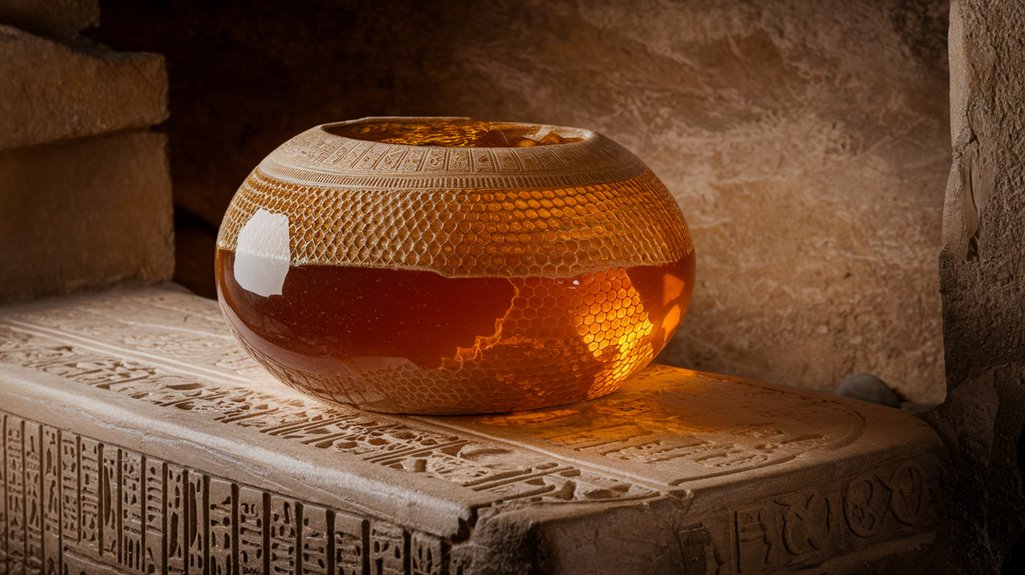
When archaeologists uncovered 3,000-year-old pots of honey in ancient Egyptian tombs, including King Tutankhamun's in 1922, they couldn't believe their eyes. The honey was still perfectly preserved and edible, challenging everything they knew about food preservation.
You might wonder how this incredible discovery came to be, as tomb artifacts rarely survive in such pristine condition. This remarkable preservation is due to honey's low water content, which makes it naturally resistant to bacterial growth.
The ancient Egyptians placed honey offerings in tombs as symbols of eternal life, but they didn't just value it for spiritual reasons. They were skilled beekeepers who understood honey's practical uses in medicine, food preservation, and mummification. Honey was so important in ancient medicine that it appeared in thirty percent of prescriptions recorded on clay tablets.
The discovery reveals their advanced knowledge of preservation techniques and highlights honey's remarkable ability to withstand the test of time, making it one of archaeology's most fascinating finds.
Nature's Perfect Preservation Formula
Inside every jar of honey lies nature's perfect preservation formula, a remarkable combination of chemical and physical properties that keeps food fresh for thousands of years.
When you examine honey's preservation benefits, you'll find it's a masterpiece of natural engineering. Its low water content and high sugar concentration create an environment where bacteria simply can't survive. Ancient Egyptians recognized this and placed honey in tombs as offerings.
The honey health secret lies in its multi-layered defense system. You're looking at a substance that's naturally acidic, produces hydrogen peroxide, and draws moisture away from microorganisms through osmosis. Powerful enzymes like invertase help maintain honey's remarkable preservation abilities.
These properties work together to create an impenetrable barrier against spoilage. Whether it's coating fruits, preserving meats, or protecting dairy products, honey's unique chemical makeup guarantees that what you're preserving today could potentially last for generations to come.
Ancient Egyptian Beekeeping and Honey Culture
The ancient Egyptians mastered honey's remarkable preservation properties and built an entire culture around beekeeping. You'll find evidence of their sophisticated beekeeping techniques in tomb paintings and temple reliefs dating back to the Fifth Dynasty, where horizontal hives and smoking methods were commonly depicted.
Their reverence for bees ran deep, as they believed these insects emerged from the sun god Re's tears. You can see this spiritual connection reflected in their honey rituals, where they'd use this golden substance for everything from religious ceremonies to burial practices. Some Egyptians even paid their taxes with honey. Honey became essential to their medical practices, with 500 of 900 prescriptions containing honey as a key ingredient.
In fact, the Egyptians were so confident in honey's preservative powers that they'd place jars of it in tombs to sustain the deceased in the afterlife. The practice was so important that they even had official titles like "Chief Beekeeper" in their administration.
The Science Behind Honey's Immortality
Scientists have uncovered the remarkable molecular mechanisms that make honey virtually immortal. When bees create honey, they reduce its water content to less than 18% and seal it in airtight chambers, creating a supersaturated sugar solution that's hostile to microbial growth. This natural process prevents honey fermentation and gives honey its incredible shelf life.
You'll find that honey's microbial resistance comes from multiple preservative mechanisms working together. Its high sugar concentration creates an inhospitable environment for bacteria, while an enzyme called glucose oxidase produces hydrogen peroxide and gluconic acid. Modern studies show that honey helps us understand unique STEM concepts. Bees contribute to honey's preservation by storing it in airtight wax containers.
These compounds act as natural disinfectants and maintain honey's acidic pH between 3.2 and 4.5. Combined with honey's hygroscopic nature, which allows it to absorb moisture from its environment, these properties explain why archaeologists continue to find edible honey in ancient Egyptian tombs.
Archaeological Evidence Through the Ages
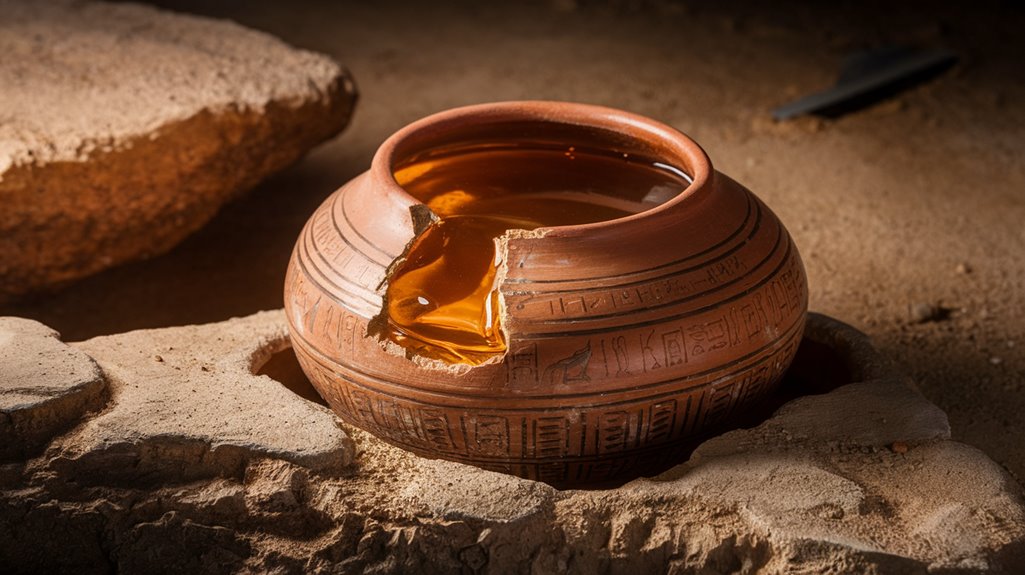
Archaeological discoveries continue to validate honey's extraordinary preservation capabilities across millennia. You'll find evidence of this remarkable substance in ancient Egyptian tombs, where archaeologists have uncovered perfectly preserved honey alongside other organic artifacts.
Through advanced archaeological techniques like 3D scanning and chemical analysis, researchers can study these ancient honey samples without compromising their integrity. Environmental monitoring tools help maintain optimal conditions for these rare honey specimens in museum settings.
What makes these discoveries particularly fascinating is how honey's natural properties align with established preservation methods. While most organic materials require specific conditions like dry, cold, or waterlogged environments to survive, honey creates its own preservative environment.
You can see this demonstrated in archaeological sites where honey has maintained its edible state despite centuries of exposure, making it one of the most stable organic substances ever discovered in ancient contexts. The hot sands of Egypt have contributed significantly to preserving these ancient honey discoveries alongside other organic materials found in tombs.
Modern Applications of Ancient Preservation Methods
While ancient civilizations may not have understood the science behind their preservation methods, many of their techniques remain relevant and effective today.
You'll find traditional techniques like honey preservation, drying, and fermentation still being used in modern kitchens worldwide, each carrying its own cultural significance.
These time-tested methods have been refined with scientific understanding and technological advances, making them more efficient and reliable than ever.
The technique of preserving food with sugar dates back to the Ancient Greeks and Romans, who pioneered methods we still use in modern food preservation.
Ancient Egyptians demonstrated remarkable foresight by using honey in embalming practices, showing its extraordinary preservative capabilities.
- Sun-drying fruits and vegetables using modern dehydrators
- Preserving meats through enhanced curing processes
- Using honey's natural antibacterial properties in food storage
- Fermenting foods under controlled conditions for ideal results
- Combining ancient pickling methods with precise pH monitoring
These preservation methods not only help extend food shelf life but also maintain nutritional value while reducing the need for artificial preservatives.

